Reconstruction of a Wendat longhouse
Today, southeastern Canada is a highly urbanized, cosmopolitan region. A recent discovery reveals that those adjectives also describe an early 1500s site where people of one of Canada’s First Nations, also called Native Americans, thrived. When Europeans were just beginning to explore North America, a settlement of the Huron people, known in their native language as the Wendat, resembled a prosperous European medieval town. Moreover, an artifact found at the Lake Ontario site connects the Canadian First Nations to a little-known chapter in European history.
Archaeologists estimate that from about 1500 to 1530, some 1,500 to 1,800 people lived in the town, now called the Mantle site. Their farms occupied an area the size of Manhattan Island. The Wendat would have hunted almost 30 miles in any direction. Found at the site were three palisades (strong defensive fences), about 200,000 artifacts, and evidence of 98 longhouses. Longhouses were large wooden structures, usually 20 feet wide, 20 feet high, and from 40 to 160 feet long. Among the artifacts was an iron ax head that had been carefully buried. A maker’s mark on the ax reveal its origin to be northern Spain. The ax was probably passed along a trade route from Newfoundland and Labrador, where Basque people from what is now northern Spain or southern France operated a whaling station. Exactly when the Basque whalers began operating in the North Atlantic is not known, but they were certainly active during the Mantle settlement’s heyday.
The Mantle site points to an often neglected fact: the peoples of North America had their own histories and relations quite apart from interactions with Europeans. For example, the Wendat were a complex confederacy of tribes that were engaged in violent conflict with Iroquois who lived farther south. All the while, they traded peacefully with the Iroquois of the St. Lawrence River area.
Image credit: © Marilyn Angel Wynn/Nativestock Pictures/Corbis
Related Links
-
Ancient “New York City” of Canada Discovered
Read what the archeologists have to say about the Mantle site.
(Source: LiveScience, July 10, 2012) -
Mantle Site, Wendat (Huron) Ancestral Village
Follow the links at the bottom of the page for more information on the site and the Wendat people.
(Source: Wikipedia; accessed July 31, 2012) -
Musée Huron-Wendat
Explore the exhibits of a museum devoted to the Huron-Wendat people, with text in either English or French; includes the virtual exhibit “Trading Ideas.”
(Source: Musée Huron-Wendat; accessed July 31, 2012) -
Wyandot People
Get some background knowledge of the Wendat people at this site.
(Source: Wikipedia; accessed July 31, 2012) -
Basque Whaling in Red Bay, Labrador
Learn more about the history of Basque whaling.
(Source: Memorial University of Newfoundland; accessed July 31, 2012)





i like it
grrreeeeaaaaaattttt (:
I lean that back then when Europeans were just beginning to explore North America , settlement of the Huron people in their native language as the wendat. The people of North America had their own histories and relation.
When Europeans were just beginning to explore North America, settlement of the Huron people in their native language as their wendat. The people of North America had their own histories and relation.
When Europeans were just beginning to explore North America, settlement of the Huron people in their native language was the wendat. The people of North America had their own histories and relation. I learned that there is a lot of languages in North America.